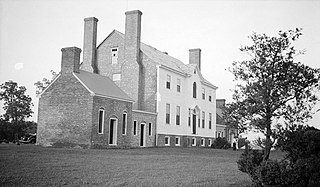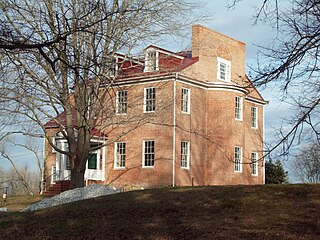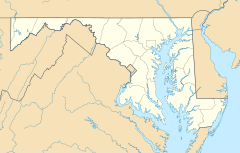
Bowie is a city in Prince George's County, Maryland, United States. Per the 2020 census, the population was 58,329. Bowie has grown from a small railroad stop to the largest municipality in Prince George's County, and the fifth most populous city and third largest city by area in the U.S. state of Maryland. In 2014, CNN Money ranked Bowie 28th in its Best Places to Live list.

Oden Bowie, a member of the United States Democratic Party, was the 34th Governor of the State of Maryland in the United States from 1869 to 1872.

The Belair Mansion, located in the historic Collington area and in Bowie, Maryland, United States, built c. 1745, is the Georgian style plantation house of Provincial Governor of Maryland, Samuel Ogle. Later home to another Maryland governor, the mansion is listed on the National Register of Historic Places.
Collington is a now defunct settlement in Prince George's County, Maryland, United States, dating from colonial times. Collington has been subsumed by the city of Bowie.

Darnall's Chance, also known as Buck House, Buck-Wardrop House, or James Wardrop House, is a historic home located at 14800 Governor Oden Bowie Drive, in Upper Marlboro, Prince George's County, Maryland, United States.

The Adelphi Mill is the only surviving historic mill in Prince George's County, Maryland. It is the oldest and largest mill in the Washington, D.C. area.

Marietta is a historic house and former tobacco plantation located in Glenn Dale, Prince George's County, Maryland. On the National Register of Historic Places and the National Underground Railroad Network to Freedom, Marietta House Museum includes a federal era house, a cemetery, the original root cellar, and harness room, as well as Judge Gabriel Duvall's original law office building. The historic site sits on 25 acres of Marietta's original 690 acres. Today, visitors can walk the grounds and tour the plantation buildings and sites where free and enslaved people lived and labored.

Rose Hill is a historic house built in the late 18th century near Port Tobacco in Charles County, Maryland, United States. It is a five-part, Georgian-style dwelling house. It has a two-story central block with gable ends. It was restored during the mid 20th century.

Broad Creek in Prince George's County was the first footprint of European settlement in the immediate counties around what would become the nation's capital, Washington, D.C. The area is part of greater Fort Washington.
William Duckett Bowie, was an American politician. The eldest child of William Bowie and Kitty Beanes Duckett, he was born at Fairview Plantation in Prince George's County, Maryland.

Gustavus Richard Brown was a lifelong friend of George Washington, a physician, helped found the hospital department of the Continental Army, and a botanist. He is best known as one of the doctors summoned to attend to George Washington the night he died.

Melford is a historic plantation house located on the grounds of the Maryland Science and Technology Center, near the intersection of U.S. Route 301 and U.S. Route 50, at Bowie, Prince George's County, Maryland. The house is multi-part, gable-roofed, brick and stone dwelling house constructed probably in the mid-late 1840s, with elements of the Greek Revival style.

Pleasant Prospect is a historic home located at Mitchellville, Prince George's County, Maryland. It is an outstanding and important example of a Federal style plantation house, consisting of a 2½-story main structure over a full basement with a 2-story kitchen linked by a 1-story hyphen. The kitchen wing and hyphen are typical of late eighteenth century ancillary architecture in Southern Maryland. The walls are laid in Flemish bond, and the chimneys are typical of Maryland; wide on the side, thin and high above the ridge, rising on the gable ends of the house flush with the building wall. The interior exhibits outstanding Federal style trim, including elaborate Adamesque moldings and plasterwork ornamentation such as garlands, swags, and urns applied to interior doorways and mantles. A pyramidal roof, log meat house stands on the immediate grounds.

Christ Episcopal Church and Cemetery is an historic Episcopal church and cemetery located at Cambridge, Dorchester County, Maryland U.S.A.

Croom is an unincorporated community and census-designated place in Southern Prince George's County, Maryland, United States. As of the 2020 census it had a population of 2,720. Croom largely consists of former tobacco farms and forests converted to Washington bedroom subdivisions such as nearby Marlton. The main part of Patuxent River Park is in Croom.
Cooksville is an unincorporated community in Howard County, Maryland, United States. As of 2016, the population was 631. The town was founded by Thomas Cook in 1802. The crossroads town was anchored by the Joshua Roberts Tavern, where General Lafayette visited in 1824. The inn was destroyed by fire, rebuilt, and demolished a second time. Thomas Cook exchanged his stake in Cooksville with Thomas Beale Dorsey for the 231-acre Round About Hills slave plantation. A Post Office opened on the 4th of July 1851, the same year Howard County was formed from a portion of Anne Arundel County. Roberts Inn was listed on the National Register of Historic Places in 1973.

The Easton Historic District is a historic district that covers most of the core of the town of Easton, Maryland. The town is the county seat of Talbot County. The state of Maryland is nearly split by the Chesapeake Bay, and Easton is located on the east side of the bay that is known as Maryland's Eastern Shore. Although the town is part of the east coast of the United States, the region's history goes back to a time when Maryland was a colonial province of England.
Foxhill Park is a 45-acre park in Bowie, Maryland, operated by the Maryland-National Capital Park and Planning Commission. It is adjacent to the Belair Mansion.
African Academy, the first permanent school in Baltimore, Maryland for African Americans. It was located at 112–116 Sharp Street, between Lombard and Pratt.
Pen Mar is an unincorporated community in Washington County, Maryland, and Franklin County, Pennsylvania, United States. It is one of the border towns in the United States with a portmanteau name. Pen Mar came to prominence as a resort in the 20th century after the construction of Pen Mar Park by the Western Maryland Railway. While the resort has long been dismantled, the area still has some significance in Maryland, since it is the northern starting point for the Maryland section of the Appalachian Trail.
















